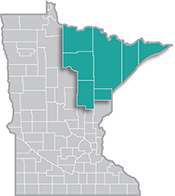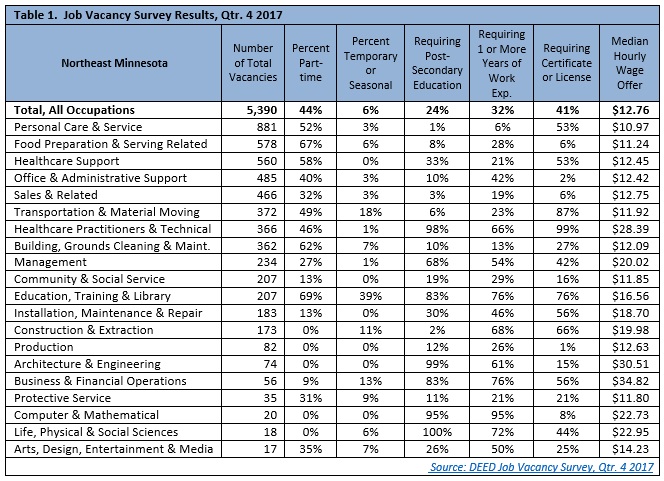 Home to the state's second-largest metro, the Northeast Region has a strong industrial sector, tied largely to the area's abundant natural resources.
Home to the state's second-largest metro, the Northeast Region has a strong industrial sector, tied largely to the area's abundant natural resources.
Most of the manufacturing base centers on mining and forest products industries. More than half of the sector's employment is in paper and machinery manufacturing.
Want the freshest data delivered by email? Subscribe to our regional newsletters.
4/16/2018 12:04:56 PM
Erik White
Newly released Job Vacancy data shows a drop in the number of job openings for the 4th quarter of 2017 in the Arrowhead region from the high-water mark of 9,762 posted earlier in the 2nd quarter of 2017. However, the 5,390 job vacancies continue a trend where the region has as many job openings as job seekers, an indication of a tight labor market (Figure 1).

Of the 5,390 job vacancies, 44 percent of them were part-time and the median hourly wage offer was $12.76. Nearly a quarter of job openings in the Arrowhead region required post-secondary education, nearly a third required one or more years of work experience, and 41 percent of the vacancies required a certificate or licensure.
The top three occupational groups based on the total number of vacancies include: Personal Care and Service, Food Preparation and Serving Related, and Healthcare Support. The job openings from these categories made up nearly 40 percent of all openings in the region, but the median hourly wage offers were all lower than the $12.76 wage offer for all vacancies, and the percent part-time was greater.
With 366 vacancies, Healthcare Practitioners and Technical occupations – such as registered nurses, licensed practical nurses, physical and occupational therapists, and doctors – had many job openings in the region and offered a median wage of $28.39 per hour. With the higher wages, 100 percent of these occupations also required post-secondary education and certificates and licensures. Also, 66 percent of the job openings in this healthcare occupation required one or more years of work experience.
Other high-paying occupational groups with vacancies reported in the region included Management ($20.02), Installation, Maintenance, and Repair ($18.70), Construction and Extraction ($19.98), Architecture and Engineering ($30.51), and Business and Financial Operations ($34.82) (Table 1).

Job Vacancy data also provides details on job openings by industry, and it comes as no surprise which industry leads the region in vacancies. Health care and Social Assistance employers reported 2,142 job vacancies, or 39.7 percent of all openings. Accommodation and Food Services had the next biggest share of job openings with 846 and Retail Trade had 581 job postings, meaning those three industries accounted for over 66 percent of total openings in the 4th quarter of 2017 (Figure 2).
Arts, Entertainment, and Recreation had only 97 job vacancies reported, more than 200 less openings than in the 2nd quarter of 2017, indicating how the time of year affects job openings in the Arrowhead region. Construction is another industry impacted by the seasons; there were 224 job postings for the 4th quarter of 2017, much less than the over 600 job vacancies recorded in the earlier vacancy survey this year.

The latest release of DEED's Job Vacancy Survey shows a downturn in job vacancies for the seven-county Arrowhead region compared to last summer. However, when compared to vacancies from previous 4th quarters, the latest results indicate a continuation of the region's tight labor market where there are as many job opening as there are job seekers. Also, the most difficult-to-fill openings in the region continue to be in Personal Care and Service and Food Preparation occupations, where median wage offers are low and a considerable amount of openings are part-time.
Contact Erik White at 218-302-8413.